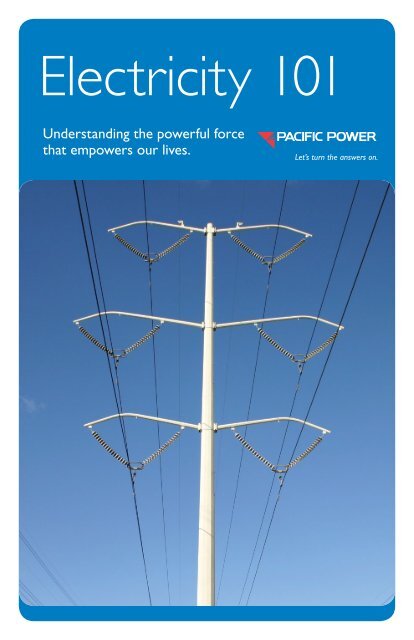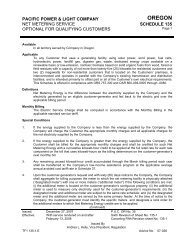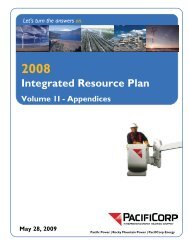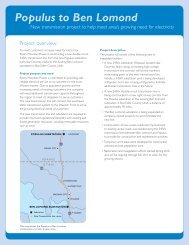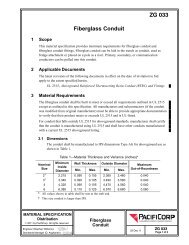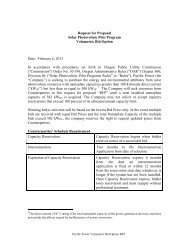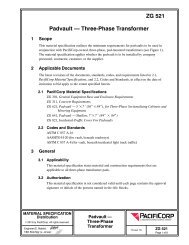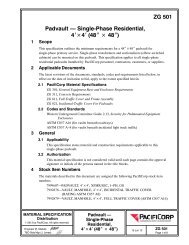Electricity 101 booklet (PP1003) - Pacific Power
Electricity 101 booklet (PP1003) - Pacific Power
Electricity 101 booklet (PP1003) - Pacific Power
You also want an ePaper? Increase the reach of your titles
YUMPU automatically turns print PDFs into web optimized ePapers that Google loves.
<strong>Electricity</strong> <strong>101</strong><br />
Understanding the powerful force<br />
that empowers our lives.<br />
Let’s turn the answers on.
Table of contents<br />
<strong>Electricity</strong>’s physical properties.............................................4<br />
Harnessing the power................................................................7<br />
Directing the current..................................................................8<br />
Playing it safe.....................................................................................11<br />
Taking serious safety precautions........................................12<br />
Harsh realities of electrical shock........................................18<br />
Giving aid to an electrical shock victim...........................20
<strong>Electricity</strong><br />
It’s such an important part of our daily lives that it is almost impossible<br />
to fathom a world without electrical power. Think about it – a power<br />
outage during a heavy storm leaves us in the dark and reminds us<br />
of how dependent we are on all that electricity provides. Knowing<br />
how electricity works and travels will help us understand it as a<br />
powerful force, one than can cause serious injury, even death, if used<br />
without caution.<br />
2
<strong>Electricity</strong>’s physical<br />
properties – What is it?<br />
Although electricity is invisible, odorless and has no shape or form, the<br />
earth’s atmosphere is charged with it. You’ll see proof of its presence<br />
during a lightning storm. Though the electricity we use in our daily lives<br />
is man-made, it is a phenomenon with absolute characteristics.<br />
<strong>Electricity</strong> always seeks a path to the ground. All electrical contact<br />
accidents occur when a person accidentally becomes part of<br />
electricity’s pathway to the ground. Making contact with a power line<br />
in the ground can be just as dangerous.<br />
<strong>Electricity</strong> travels at the speed of light. It is made up of electrons<br />
that flow rapidly in an electrical current. Electrical currents move so<br />
fast, in fact, that they cover the distance of the world’s circumference<br />
7.5 times per second.<br />
<strong>Electricity</strong> is attracted to materials known as “conductors” that<br />
allow it to flow readily. Some conductors include:<br />
• Metal<br />
• Water<br />
• Wet objects<br />
• Trees (they contain moisture)<br />
• People (bodies contain water)<br />
• Dirt on insulators<br />
Unlike conductors, electricity does not flow easily through certain<br />
insulating materials, such as:<br />
• Rubber<br />
• Glass<br />
• Plastic<br />
• Porcelain<br />
4
Harnessing the power<br />
The electricity we use every day is generated in power plants where<br />
energy from several sources in nature is converted into electricity. For<br />
example, plants can generate hydroelectric power from rivers, solar<br />
power from the sun, fossil-based energy from coal, oil or natural gas,<br />
and wind power from the wind.<br />
To generate energy from natural sources we use a few basic principles<br />
of physical science in our power plants, which house power generators<br />
comprised of large magnets that spin inside coils of wire. To get the<br />
magnets spinning, high-pressure steam or water is forced against<br />
the generator’s turbine blades. As the loops of wire rotate between<br />
magnetic poles, a flow of electrons, or electric current, is produced.<br />
It is then transferred to transmission lines for distribution through a<br />
vast power grid.<br />
In addition to all those sources, electricity can be generated by burning<br />
so-called biofuels to create energy that churns the turbines in the<br />
generators. Biofuels are produced from forest by-products and renewable<br />
agricultural crops, including vegetative and organic waste matter.<br />
The steam used to spin magnets in generators usually is produced from energy created<br />
by burning coal, natural gas or oil, from harnessing nuclear energy, and sometimes from<br />
geothermal sources. Dams and reservoirs on rivers harness the force of water that is<br />
released and used to spin the turbines. Now, more than ever before, wind power is being<br />
used to generate electricity.<br />
7
Directing the current<br />
Getting electricity from one point to another requires a complex<br />
network of transmission and distribution lines. Operating as a power<br />
distribution highway, electrical current travels along a designated path,<br />
sometimes traveling great distances to “load centers” where it is used.<br />
In order for the electricity to go great distance, the “pressure”, or<br />
voltage, is increased.<br />
For safety purposes, very tall towers and poles are used to drape highvoltage<br />
transmission lines so they are high in the air and away from<br />
people and activity. Transmission lines transport electricity from its<br />
source to cities. Here the lines enter a substation where the voltage –<br />
or pressure – is lowered so it can be safely distributed to the local<br />
area. The electricity then flows out of the substation over distribution<br />
lines to either pole-top or underground transformers.<br />
The job of the transformer is to lower, or transform, the voltage to the<br />
typical 120/240 level used in homes and small businesses. Transformers<br />
serving underground lines are housed in green metal boxes called padmounted<br />
ground transformers that rest above ground. The line hung<br />
from a pole to a home is called a service drop. This line carries the<br />
electricity through the meter into the circuits of homes and businesses.<br />
8
Playing it safe<br />
Electrical-related accidents can occur anywhere and anytime a person<br />
or conductor interrupts the flow of the current, providing it a path to<br />
the ground. Most of the time, using common sense and extra caution<br />
around electricity will prevent such accidents.<br />
Look up<br />
Most accidents associated with electricity occur when someone<br />
comes into contact with overhead power lines. That’s why you must<br />
always be aware of your proximity to such lines, especially when<br />
lifting or moving tall or long objects such as rain gutters, TV antennas,<br />
pool skimmers, irrigation pipes and ladders. Such objects can conduct<br />
electricity directly through your body as it moves from the line to<br />
the ground. Another thing to remember: never fly kites or model<br />
airplanes around these lines.<br />
Call before you dig<br />
Digging into underground power lines is just as dangerous as coming<br />
into contact with an overhead line. While these underground lines<br />
are insulated, they are not designed to resist a shovel or backhoe<br />
blades. Digging into underground lines, in addition to being a safety<br />
hazard, can sever the line, causing expensive damage as well as the<br />
inconvenience of interrupted power. Because an increasing number<br />
of homes are serviced by underground electric cables, it is important<br />
to locate these cables before you disrupt the soil. To have your lines<br />
located free of charge, call 811 at least 48 hours before you plant<br />
a tree, dig holes for fence posts or install underground sprinklers.<br />
Stay away to stay safe<br />
The transmission and electrical lines you see draped on poles<br />
throughout neighborhoods are not insulated. For safety purposes, we<br />
hang these power lines high in the air, away from people and activity.<br />
Even in cases where service drops are insulated, the insulation can<br />
break down over time and render the line dangerous. To be on<br />
the safe side, treat all power lines you see as being energized and<br />
dangerous. Simply stay away from them.<br />
11
Taking serious safety<br />
precautions<br />
Around the house<br />
To avoid electrical-related accidents around the house, always be alert<br />
for unsafe situations. For example, you should “childproof” electrical<br />
outlets, discard worn or frayed cords, avoid circuit overloading and<br />
use ground fault circuit interrupter devices (GFCIs). GFCIs are outlets<br />
equipped with “test” and “reset” buttons. In some states, these<br />
devices include a sticker indicating the “test” and “reset” buttons<br />
are on the breaker. When installed properly, GFCIs will instantly<br />
disconnect power to an outlet if a short-circuit or grounding event<br />
has occurred with the appliance.* GFCIs are important safety devices<br />
particularly for bathrooms, kitchens, garages and outdoors where<br />
electric appliances are frequently used in proximity to water. Always<br />
remember that electrical appliances and water don’t mix. Keep items<br />
such as radios and hair dryers away from sinks, bathtubs and puddles.<br />
* Even with a GFCI, injury may occur.<br />
Tree pruning<br />
Pruning trees is another task that requires extra caution when<br />
overhead power lines are in the proximity. That’s because a tree or<br />
branch can fall into a line creating an electrical path to the ground<br />
that can run through you and the tree. To prevent such an accident<br />
remember these key points:<br />
• Always be aware of your proximity to power lines – stay as far away<br />
as possible.<br />
• Branches can conduct electricity.<br />
• Wood- or fiberglass-handled tools can conduct electricity if the handle is<br />
wet or dirty.<br />
• If any trees on your property are growing into power lines or if you need<br />
assistance, contact <strong>Pacific</strong> <strong>Power</strong> toll free at 1-888-221-7070. Do not<br />
attempt to prune them yourself.<br />
12
Rooftop projects<br />
Long or tall objects inadvertently coming into contact with power<br />
lines are major causes of electrical-related accidents and can be fatal.<br />
Antennas, ladders, satellite dishes, rain gutters, pool skimmers and<br />
other similar objects should be kept away from overhead lines. That<br />
is because such objects typically are metal and conduct electricity,<br />
causing risk of serious injury or death to the person holding them.<br />
To avoid such accidents, you should:<br />
• Always be aware of power line location when installing or moving<br />
anything on or near your roof.<br />
• Stay as far away as possible – and at least 10 feet away – from all<br />
overhead power lines.<br />
• Be aware that shock from electrical contact can lead to secondary<br />
injuries, such as falling from a roof.<br />
Storms and downed power lines<br />
It can happen in an instant – a storm can take down a power line<br />
causing it to come in contact with and energize a tree, a fence and the<br />
ground around it. In such a case, caution is paramount. You should<br />
stop, think, look around you and don’t make a move that could cause<br />
you pain or even prove to be fatal. <strong>Electricity</strong> will travel through any<br />
conductor, including you.<br />
• Never touch or go near a fallen power line, and do not touch anything<br />
on which the wire is resting. Always assume a downed line and the ground<br />
surrounding it are energized and dangerous.<br />
• If you see a downed line, tell others to stay away and immediately call 911,<br />
then call us toll free at 1-888-221-7070.<br />
• Do not touch or go near a person in contact with a downed power line.<br />
Call 911.<br />
• If a power line falls across your car while you are inside, stay put until help<br />
arrives. If you attempt to leave the vehicle, you may be electrocuted. If<br />
the car is on fire and you must exit, jump as far away as possible, with<br />
both feet together. Take care never to be in contact with the car and the<br />
ground at the same time. Continue to hop, with both feet together, away<br />
from the area.<br />
14
Generator safety<br />
If you use a portable electric generator, use an approved transfer<br />
switch to prevent back-feed into nearby power lines. Such back-feed<br />
is a safety hazard and can damage your property. In addition, it can<br />
create a hazard to our line repair personnel as they work to restore<br />
power. A few more safety tips: never plug your generator into an<br />
outlet and do not connect a generator directly into your home’s<br />
main fuse box or circuit panel. Generator exhaust contains potentially<br />
dangerous carbon monoxide. Never use a generator indoors. Locate<br />
your generator outdoors where it will vent safely, away from doors,<br />
windows and vents in your home.<br />
15
On the job<br />
Most electrical injuries sustained on the job are associated with a<br />
conductive object, such as metal, coming into contact with overhead<br />
wires. This diverts the electricity from the wires to the ground through<br />
the person handling the metal. At work sites you should:<br />
• Use the help of “spotters” when operating lift trucks or other power<br />
equipment.<br />
• Always work with a heightened sense of electrical awareness.<br />
• Be aware of overhead lines – look up and always observe the 10-foot circle<br />
of safety. Keep tools and materials you are handling and the equipment you<br />
are operating at least 10 feet away from all power lines. Stay even further<br />
away if you’re working around lines transmitting 50,000 volts or higher. Also<br />
remember, the minimum approach distance is 20 feet for cranes and<br />
derricks. Not only is this an important safety rule, it’s the law.<br />
• If you cannot get your work done without moving into the 10-foot circle<br />
of safety, call <strong>Pacific</strong> <strong>Power</strong> toll free at 1-888-221-7070. We will help you<br />
do the job safely by de-energizing or grounding the lines or by using other<br />
safety measures.<br />
• If a crane, tractor or other piece of boom-type equipment comes into<br />
contact with an overhead power line the operator should move the<br />
equipment away from the line only if it can be done without knocking down<br />
the line or pole. If the operator cannot move the equipment without causing<br />
further hazards, he or she should stay put until the power can be turned off.<br />
The operator should never step off the equipment because contact<br />
between the energized equipment and the ground can result in<br />
electrocution. In such a case, warn others to stay a safe distance from the<br />
area until the power can be turned off. That is important because the<br />
ground surrounding the equipment will be energized by the electricity<br />
making its way through the equipment to the ground.<br />
• In emergency situations, such as a fire, the operator should get off the<br />
equipment by jumping as far as possible from the machinery with feet<br />
together. He or she should use extra caution to not be in contact with the<br />
equipment and the ground at the same time. The operator should hop away<br />
with both feet together.<br />
• Metal irrigation pipe and similar materials should be stacked away from<br />
overhead lines. Never tip pipes near power lines to clean. Be aware of the<br />
location of overhead lines and keep a safe distance from them before lifting<br />
or moving irrigation pipes.<br />
• Before excavating, locate all underground utilities. This can be accomplished<br />
at no cost. Simply call 811 at least 48 hours before you plan to dig.<br />
17
The dangers of<br />
electrical shock<br />
<strong>Electricity</strong> can be dangerous because of the multiple impacts it can have<br />
on the human body. That is especially true for hazards associated with<br />
“household” current. Shock from low-voltage or low-amperage current<br />
can cause the heart to go into uncontrolled spasms because the current<br />
disrupts the body’s normal circuitry. This could result in a heart attack or<br />
seizure. Higher voltages can cause serious external and internal burns.<br />
In many instances, high-voltage accidents result in lifelong disabilities or<br />
they can be fatal.<br />
Secondary impacts of job-related accidents can occur at the time of<br />
electrical contact. The electrical charge can cause loss of body control<br />
that can result in injuries related to falling from trees, buildings or other<br />
dangerous locations.<br />
18
Electrical shock and<br />
the human body<br />
An amp is a unit of measurement of current. A milliamp is .001 amp or<br />
1/1000th of an amp. Typical household currents range from 1 amp for an<br />
electric mixer, 10 amps for a toaster and 50 amps for an electric range.<br />
Warning: Common household fuses or circuit breakers will not trip until<br />
current reaches 15,000-20,000 ma.<br />
Contact with just 20 milliamps of current can be fatal.<br />
2,000 ma (2 amps)<br />
Cardiac standstill,<br />
internal organ damage<br />
Over 200 ma (.2 amps)<br />
Severe burns,<br />
may be fatal<br />
50-200 ma (.05-.2 amps)<br />
Ventricular fibrillation,<br />
may be fatal<br />
20-50 ma (.02-.05 amps)<br />
Difficult breathing, may<br />
cause damage to brain tissue<br />
and blood vessels, may be fatal<br />
15-20 ma (0.15-.02 amps)<br />
Loss of muscle control<br />
8-15 ma (.008-.015 amps)<br />
Pain<br />
1-8 ma (.001-.008 amps)<br />
Sensation, tingling<br />
Current in milliamps (ma)<br />
19
Giving aid to an electrical<br />
shock victim<br />
Do not attempt to aid the victim until the source of the current<br />
is shut off and the victim is no longer a path to the ground.<br />
Touching a person who is in contact with an electrical current provides<br />
the electricity with another path to the ground – through the rescuer.<br />
This could cause injury to the rescuer, and rescuers cannot provide help<br />
to victims if they are victims themselves. Normal instincts to provide<br />
assistance to a shock victim must be held in check long enough to<br />
analyze the situation. Despite what may be a very strong desire to<br />
help, it is essential to wait until the contact with the electrical source<br />
no longer exists or the current source is shut off.<br />
Call 911 or call us at 1-888-221-7070 immediately for assistance, and<br />
keep others away from the injured person or any downed line.<br />
20
To order safety materials or schedule a presentation<br />
on safety issues, call us at 1-800-375-7085 or visit<br />
pacificpower.net/safety. For all other information<br />
and for safety assistance around power lines, call toll free<br />
anytime at 1-888-221-7070.<br />
© 2011 <strong>Pacific</strong> <strong>Power</strong><br />
Let’s turn the answers on.


